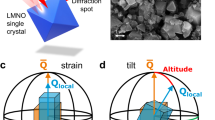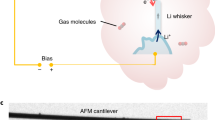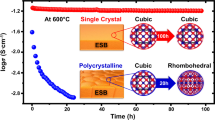Abstract
Harvesting the promising high energy density of advanced electrode materials in lithium-ion batteries is critically dependent on a mechanistic understanding on how the materials function and degrade along with the battery cycling. Here, we tracked phase transformations during (de)lithiation of Sb2Se3 single crystals using in situ high-resolution transmission electron microscopy (HRTEM) technique, and revealed electro-chemo-mechanical evolution at the reaction interface. The effect of this electro-chemo-mechanical coupling has a complicated interplay on the lithiation kinetics and causes various types of defects at the reaction front, including dislocation dipoles, antiphase boundaries, and cracks. In return, the formed cracks and related defects build a path for fast diffusion of lithium ions and trigger a highly anisotropic lithiation at the twisted reaction front, giving rise to the formation of presumably “dead” Sb2Se3 nanodomains in amorphous LixSb2Se3. The detailed mechanistic understanding may facilitate the rational design of high-capacity electrode materials for battery applications.
摘要
高能量密度的锂离子电池先进电极材料的开发, 依赖于对材料 在电池循环中的运行和失效机制的理解. 本文使用原位高分辨TEM技 术跟踪了Sb2Se3单晶锂化/脱锂过程中的相变, 并揭示了反应界面处的 电化学-力学耦合. 这种电化学-力学耦合效应对锂化动力学具有复杂 的相互作用, 并在反应前端引起各种类型的缺陷, 包括位错对、反相边 界和裂纹. 另一方面, 形成的裂缝和相关缺陷为锂离子的快速扩散开辟 了道路, 并在扭曲的反应前沿引发高度各向异性的锂化, 从而在无定形 LixSb2Se3中形成可能“失效”的Sb2Se3畴. 我们对Sb2Se3电化学过程机理的 详细研究有助于更合理地设计和制备高容量电极材料.
Similar content being viewed by others
References
Choi JW, Aurbach D. Promise and reality of post-lithium-ion batteries with high energy densities. Nat Rev Mater, 2016, 1: 16013
Zhu Z, Yu D, Yang Y, et al. Gradient Li-rich oxide cathode particles immunized against oxygen release by a molten salt treatment. Nat Energy, 2019, 4: 1049–1058
Larcher D, Tarascon JM. Towards greener and more sustainable batteries for electrical energy storage. Nat Chem, 2015, 7: 19–29
Li W, Zeng L, Wu Y, et al. Nanostructured electrode materials for lithium-ion and sodium-ion batteries via electrospinning. Sci China Mater, 2016, 59: 287–321
Baggetto L, Ganesh P, Sun CN, et al. Intrinsic thermodynamic and kinetic properties of Sb electrodes for Li-ion and Na-ion batteries: Experiment and theory. J Mater Chem A, 2013, 1: 7985–7994
Luo C, Xu Y, Zhu Y, et al. Selenium@mesoporous carbon composite with superior lithium and sodium storage capacity. ACS Nano, 2013, 7: 8003–8010
Li Q, Du P, Yuan Y, et al. Real-time TEM study of nanopore evolution in battery materials and their suppression for enhanced cycling performance. Nano Lett, 2019, 19: 3074–3082
Chen X, Li H, Yan Z, et al. Structure design and mechanism analysis of silicon anode for lithium-ion batteries. Sci China Mater, 2019, 62: 1515–1536
Davis AL, Garcia-Mendez R, Wood KN, et al. Electro-chemo-me-chanical evolution of sulfide solid electrolyte/Li metal interfaces: Operando analysis and ALD interlayer effects. J Mater Chem A, 2020, 8: 6291–6302
Wang P, Qu W, Song W, et al. Electro-chemo-mechanical issues at the interfaces in solid-state lithium metal batteries. Adv Funct Mater, 2019, 29: 1900950
Park CM, Kim JH, Kim H, et al. Li-alloy based anode materials for Li secondary batteries. Chem Soc Rev, 2010, 39: 3115
Obrovac MN, Chevrier VL. Alloy negative electrodes for Li-ion batteries. Chem Rev, 2014, 114: 11444–11502
Sharma K, Singh R, Ichikawa T, et al. Lithiation mechanism of antimony chalcogenides (Sb2X3; X = S, Se, Te) electrodes for high-capacity all-solid-state Li-ion battery. Int J Energy Res, 2021, 45: 11135–11145
Ma J, Wang Y, Wang Y, et al. One-dimensional Sb2Se3 nanostructures: Solvothermal synthesis, growth mechanism, optical and electrochemical properties. CrystEngComm, 2011, 13: 2369
Nam KH, Park CM. 2D layered Sb2Se3-based amorphous composite for high-performance Li- and Na-ion battery anodes. J Power Sources, 2019, 433: 126639
Nam KH, Park CM. Layered Sb2Te3 and its nanocomposite: A new and outstanding electrode material for superior rechargeable Li-ion batteries. J Mater Chem A, 2016, 4: 8562–8565
Hobson TDC, Durose K. Protocols for the miller indexing of Sb2Se3 and a non-X-ray method of orienting its single crystals. Mater Sci Semicond Process, 2021, 127: 105691
Pattini F, Rampino S, Mezzadri F, et al. Role of the substrates in the ribbon orientation of Sb2Se3 films grown by low-temperature pulsed electron deposition. Sol Energy Mater Sol Cells, 2020, 218: 110724
Wang X, Wang H, Li Q, et al. Antimony selenide nanorods decorated on reduced graphene oxide with excellent electrochemical properties for Li-ion batteries. J Electrochem Soc, 2017, 164: A2922–A2929
Wang W, Xu J, Xu Z, et al. Ultrafine antimony (Sb) nanoparticles encapsulated into a carbon microfiber framework as an excellent LIB anode with a superlong life of more than 5000 cycles. Nanotechnology, 2020, 31: 215403
Li W, Deng L, Wang X, et al. Close-spaced thermally evaporated 3D Sb2Se3 film for high-rate and high-capacity lithium-ion storage. Nanoscale, 2021, 13: 9834–9842
Wang S, Yang X, Lee PK, et al. Mechanically and structurally stable Sb2Se3/carbon nanocomposite as anode for the lithium-ion batteries. J Alloys Compd, 2021, 874: 159859
Wang S, Yang X, Lee PK, et al. Reversible interaction of Sb with an active Se matrix enhances the cycle stability of electrodes for lithiumion batteries. Chem Mater, 2019, 31: 2469–2475
Kumar A, Kumar V, Romeo A, et al. Raman spectroscopy and in situ XRD probing of the thermal decomposition of Sb2Se3 thin films. J Phys Chem C, 2021, 125: 19858–19865
Cheng Y, Yao Z, Zhang Q, et al. In situ atomic-scale observation of reversible potassium storage in Sb2S3@carbon nanowire anodes. Adv Funct Mater, 2020, 30: 2005417
Ding Z, Yang C, Zou J, et al. Reaction mechanism and structural evolution of fluorographite cathodes in solid-state K/Na/Li batteries. Adv Mater, 2020, 33: 2006118
Gong Y, Chen Y, Zhang Q, et al. Three-dimensional atomic-scale observation of structural evolution of cathode material in a working all-solid-state battery. Nat Commun, 2018, 9: 3341
Yang L, Zeng J, Zhou L, et al. Orderly defective superstructure for enhanced pseudocapacitive storage in titanium niobium oxide. Nano Res, 2021, 15: 1570–1578
Shao R, Chen S, Dou Z, et al. Atomic-scale probing of reversible Li migration in 1T-V1+xSe2 and the interactions between interstitial V and Li. Nano Lett, 2018, 18: 6094–6099
Zhu C, Shao R, Chen S, et al. In situ visualization of interfacial sodium transport and electrochemistry between few-layer phosphorene. Small Methods, 2019, 3: 1900061
Luo W, Calas A, Tang C, et al. Ultralong Sb2Se3 nanowire-based freestanding membrane anode for lithium/sodium ion batteries. ACS Appl Mater Interfaces, 2016, 8: 35219–35226
Shao R, Yang C, Yang C, et al. In situ TEM revealing the effects of dislocations on lithium-ion migration in transition metal dichalco-genides. J Energy Chem, 2021, 58: 280–284
Ma X, Luo W, Yan M, et al. In situ characterization of electrochemical processes in one dimensional nanomaterials for energy storages devices. Nano Energy, 2016, 24: 165–188
Wirth R. Focused ion beam (FIB) combined with SEM and TEM: Advanced analytical tools for studies of chemical composition, microstructure and crystal structure in geomaterials on a nanometre scale. Chem Geol, 2009, 261: 217–229
Zhong XL, Haigh SJ, Zhou X, et al. An in-situ method for protecting internal cracks/pores from ion beam damage and reducing curtaining for TEM sample preparation using FIB. Ultramicroscopy, 2020, 219: 113135
Kim S, Yao Z, Lim JM, et al. Atomic-scale observation of electro-chemically reversible phase transformations in SnSe2 single crystals. Adv Mater, 2018, 30: 1804925
Yu L, Chen J, Fu ZW. Pulsed laser deposited heterogeneous mixture of Li2Se-Sb2Se3 nanocomposite as a new storage lithium material. Elec-trochim Acta, 2010, 55: 1258–1264
Wu Y, Luo W, Gao P, et al. Unveiling the microscopic origin of asymmetric phase transformations in (de)sodiated Sb2Se3 with in situ transmission electron microscopy. Nano Energy, 2020, 77: 105299
Ghosh C, Singh MK, Parida S, et al. Phase evolution and structural modulation during in situ lithiation of MoS2, WS2 and graphite in TEM. Sci Rep, 2021, 11: 9014
Chen S, Wang L, Shao R, et al. Atomic structure and migration dynamics of MoS2/LixMoS2 interface. Nano Energy, 2018, 48: 560–568
Wu Y, Xu X, Zhu C, et al. In situ visualization of structural evolution and fissure breathing in (de)lithiated H2V3O8 nanorods. ACS Energy Lett, 2019, 4: 2081–2090
Xue MZ, Fu ZW. Pulsed laser deposited Sb2Se3 anode for lithium-ion batteries. J Alloys Compd, 2008, 458: 351–356
Chen S, Yang C, Shao R, et al. Direct observation of Li migration into V5S8: Order to antisite disorder intercalation followed by the topotactic-based conversion reaction. ACS Appl Mater Interfaces, 2020, 12: 36320–36328
Acknowledgements
The work was supported by the National Key R&D Program of China (2018YFB1304902), the National Natural Science Foundation of China (11904372, U1813211, and 12004034), Beijing Institute of Technology Research Fund Program for Young Scholars, Beijing Institute of Technology Laboratory Research Project (2019BITSYA03), and China Postdoctoral Science Foundation Funded Project (2021M690386).
Author information
Authors and Affiliations
Contributions
Shao R and Dong L conceived the idea; Sun C and Hua Z prepared the TEM sample; Zuo X, Bao L, and Chang X conducted the characterization of materials. Yang L and Chen H conceived the finite-element analysis; Liu T, He Y, and Han X wrote the paper. All authors contributed to the general discussion.
Corresponding authors
Additional information
Conflict of interest
The authors declare that they have no conflict of interest.
Supplementary information
Supporting data are available in the online version of the paper.
Chunhao Sun received his BS degree from the North University of China in 2019 and he is now a master’s student at the North University of China. His current research focuses on solid-state ionics, and the structure and properties of crystal defects and interfaces by in-situ TEM.
Ruiwen Shao is an assistant professor at the School of Medical Technology, Beijing Institute of Technology, Beijing, China. He received his PhD degree in condensed mater physics from the Institute of Microstructure and Properties of Advanced Materials, Beijing University of Technology in 2016. He was a postdoctor at the School of Physics, Peking University (2016–2018), and research associate at the Technical Institute of Physics and Chemistry (2018–2019). He joined Beijing Institute of Technology in 2019. His research interests include electron microscopy, solid-state ionics, and structure and properties of crystal defects and interfaces.
Tiansheng Liu is a second-level professor of the North University of China (Department of Chemical Engineering and Special Energy). He won the second and third National Invention Awards, and was a visiting scholar of Haven National Laboratory, New York, USA. His main research interests are high-temperature and high-pressure condensed matter physics and chemical reactions and new materials and application engineering.
Yang He is a professor at the School of Materials Science and Engineering, University of Science and Technology Beijing, China. He received his PhD degree from the Department of Mechanical Engineering, University of Pittsburgh in 2018. He was a postdoctor in Pacific Northwest National Laboratory from 2018 to 2019. His research interests mainly focus on exploring the structure-activity relationship of materials by in-situ TEM method and their potential applications in metal structural materials, second batteries, catalysis, etc.
Lixin Dong received his PhD degree from Nagoya University in 2003. Between 2003 and 2004, he was an assistant professor at Nagoya University, and between 2004 and 2008, he held a Senior Research Scientist at ETH Zurich. Prior to joining the City University of Hong Kong as a professor, he had been an associate professor at Michigan State University by 2019. His current interests include micro-/nanorobotics and enabling technologies for mechatronic, fluidic, photonic, and biomedical systems.
Rights and permissions
About this article
Cite this article
Sun, C., Dong, W., Yang, L. et al. Anisotropic lithium-ion migration and electro-chemo-mechanical coupling in Sb2Se3 single crystals. Sci. China Mater. 65, 2657–2664 (2022). https://doi.org/10.1007/s40843-022-2051-3
Received:
Accepted:
Published:
Issue Date:
DOI: https://doi.org/10.1007/s40843-022-2051-3




